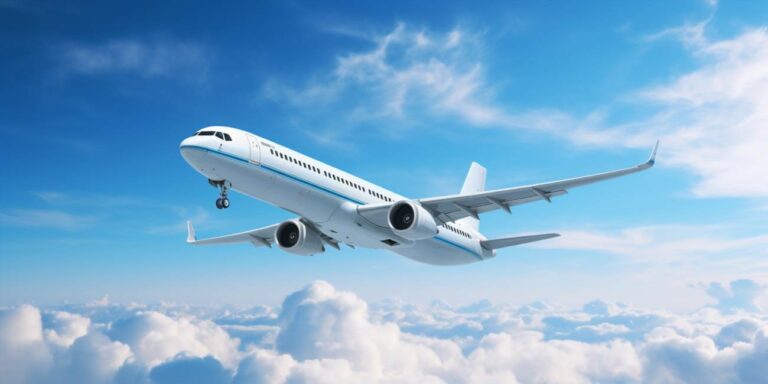One of the critical factors influencing a plane’s cruising altitude is its design and capabilities. Generally, commercial airlines reach cruising altitudes between 30,000 and 40,000 feet. This altitude provides an optimal balance between fuel efficiency and passenger comfort. At this height, aircraft can capitalize on thinner air, reducing drag and improving fuel efficiency.
It’s important to note that not all planes fly at the same altitude. Long-haul flights often operate at the higher end of the spectrum, around 35,000 to 40,000 feet, to cover vast distances more efficiently. On the other hand, shorter flights might maintain lower altitudes to facilitate smoother ascent and descent phases, enhancing overall travel experience.
The Altitude Control System (ACS) plays a pivotal role in determining how high a plane can fly. This sophisticated system allows pilots to manage and adjust the aircraft’s altitude during different phases of the flight. It ensures a smooth climb to the designated cruising altitude and a controlled descent during landing.
Another factor influencing cruising altitude is air traffic management. Air traffic controllers coordinate aircraft movements to prevent collisions and optimize airspace usage. Different flight routes and airways are designated for planes traveling in opposite directions, further contributing to the safe coexistence of flights at various altitudes.
| Aircraft Type | Typical Cruising Altitude |
|---|---|
| Boeing 737 | 30,000 to 37,000 feet |
| Airbus A380 | 35,000 to 40,000 feet |
| Boeing 777 | 32,000 to 43,000 feet |
These values, however, are not absolute. Pilots and air traffic controllers may make adjustments based on real-time conditions, such as weather patterns and air turbulence, to ensure the safety of passengers and the aircraft.
What is the highest altitude a plane can reach and still fly safely
Have you ever wondered how high a plane can soar into the sky and still navigate the vast expanse safely? The highest altitude a plane can reach and continue flying safely depends on various factors, including the type of aircraft, engine capabilities, and environmental conditions.
Commercial airliners, such as the iconic Boeing 747 or the modern Airbus A380, typically cruise at altitudes ranging from 30,000 to 40,000 feet (approximately 9,000 to 12,000 meters). These altitudes provide a balance between fuel efficiency, aerodynamic performance, and passenger comfort. The lower air density at higher altitudes reduces drag, enabling the aircraft to achieve better fuel economy.
For military aircraft and specialized high-altitude planes, the altitude ceiling can be significantly higher. Some reconnaissance planes and spy aircraft, like the Lockheed U-2, are designed to operate at altitudes exceeding 70,000 feet (21,000 meters). These extreme altitudes serve strategic purposes, allowing these planes to conduct surveillance and intelligence gathering while staying above the range of most enemy defenses.
One crucial factor in determining the highest safe altitude is the service ceiling of the aircraft. The service ceiling represents the maximum altitude at which the aircraft can maintain a steady climb rate of 100 feet per minute. Beyond this point, the engines may struggle to generate enough thrust, and the aircraft’s performance could be compromised.
It’s important to note that aircraft designed for high-altitude flight are equipped with specialized systems. These may include pressurized cabins to ensure the well-being of passengers and crew at extreme altitudes where oxygen levels are insufficient. Without pressurization, individuals would be at risk of experiencing hypoxia, a condition caused by inadequate oxygen supply.
Environmental factors also play a crucial role. The stratosphere, which extends from approximately 8 miles (13 kilometers) to 31 miles (50 kilometers) above the Earth’s surface, presents unique challenges. While the air is thin, providing less resistance, the extreme cold temperatures can impact the aircraft’s systems and materials.
How do planes manage to fly so high without exploding

Have you ever looked out of an airplane window and marveled at the vast expanse of the sky, wondering how these colossal machines manage to soar through the heavens without succumbing to the challenges of air pressure and oxygen levels? The answer lies in a delicate balance of engineering marvels and careful planning.
First and foremost, let’s delve into the concept of air pressure. As an aircraft climbs higher into the atmosphere, the air pressure decreases significantly. This is a critical factor that aircraft designers must consider. At high altitudes, where the air is thin, there is less force exerted on the aircraft’s structure. To counteract this, airplanes are constructed with sturdy materials capable of withstanding the diminished air pressure at cruising altitudes.
Now, when it comes to oxygen levels, the situation becomes even more complex. As an airplane ascends, the concentration of oxygen molecules in the air decreases, making it challenging for passengers and crew to breathe comfortably. To address this, aircraft are equipped with sophisticated pressurization systems. These systems ensure a continuous and controlled supply of oxygen within the cabin, maintaining oxygen levels at a safe and breathable standard. Without this crucial feature, passengers and crew members would face severe health risks due to hypoxia.
The process of pressurization involves regulating the air pressure inside the cabin to simulate conditions found at lower altitudes. This ensures that passengers can enjoy a comfortable and safe flight experience. The aircraft’s fuselage is a robust structure that can withstand the pressure differentials between the inside and outside environments, preventing any catastrophic failure due to the changing air pressure.
Picture this: an invisible shield enveloping the aircraft, maintaining a delicate equilibrium between the thin air of high altitudes and the breathable atmosphere we are accustomed to on the ground. The engineering behind this phenomenon is nothing short of extraordinary.
Why do some planes fly higher than others
When it comes to the altitude prowess of aircraft, several factors come into play, each dictating how high a plane can soar through the skies. The aircraft model is a fundamental determinant of its maximum cruising altitude. Different aircraft models are designed with varying specifications, affecting their aerodynamic capabilities and overall performance.
Consider the sleek and advanced models like the Boeing 787 Dreamliner or the Airbus A350. These cutting-edge planes are crafted with state-of-the-art materials and innovative designs, contributing to their superior aerodynamic efficiency. The utilization of lightweight materials in their construction allows for a more favorable thrust-to-weight ratio, enabling these aircraft to reach altitudes that were once considered unattainable.
However, an aircraft’s ability to climb to great heights isn’t solely dependent on its model. Engine power plays a crucial role in determining the altitude it can reach. High-performance engines, often characterized by advanced technologies like turbofan or turbojet propulsion, provide the necessary thrust for a plane to ascend rapidly and maintain a higher cruising altitude.
Take, for instance, the General Electric GE90 engines employed in some Boeing 777 variants. These powerhouses boast immense thrust capabilities, allowing the aircraft to reach impressive altitudes. The engine power is not only about raw strength but also about fuel efficiency, as modern engines are designed to deliver optimal performance while minimizing fuel consumption, contributing to the overall efficiency of the flight.
Now, let’s delve into the fascinating realm of aerodynamics. The science of how air interacts with the surfaces of an aircraft is pivotal in determining its flight characteristics, including its maximum altitude. The wings, tail, and overall shape of the aircraft are meticulously designed to harness the principles of aerodynamics, optimizing lift and minimizing drag.
Wing design, in particular, is a critical aspect of achieving higher altitudes. Aircraft with longer wingspans often enjoy enhanced lift capabilities. The curvature and shape of the wings are meticulously engineered to exploit the Bernoulli’s principle, generating lift as air flows over and under the wings. This careful consideration of aerodynamics allows certain planes to cut through the air more efficiently, enabling them to climb to greater heights.






